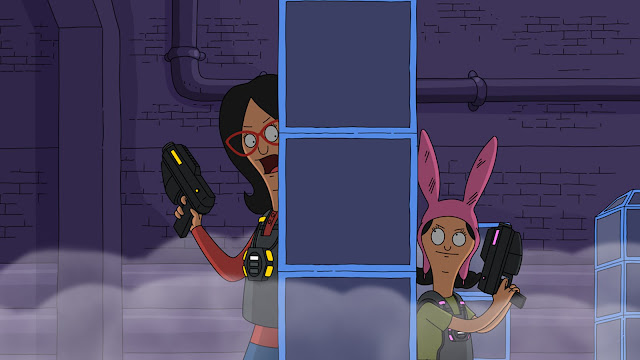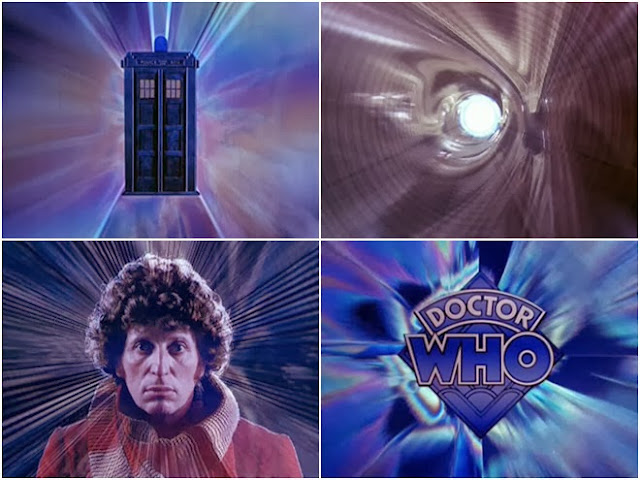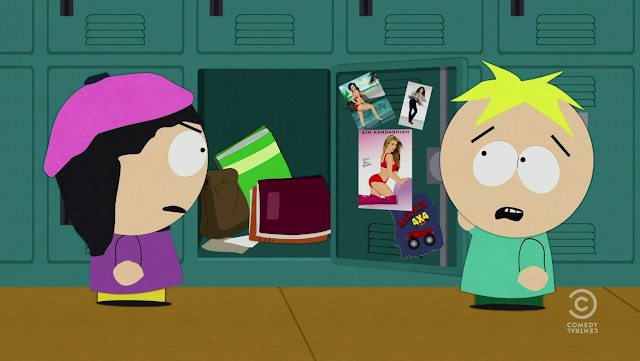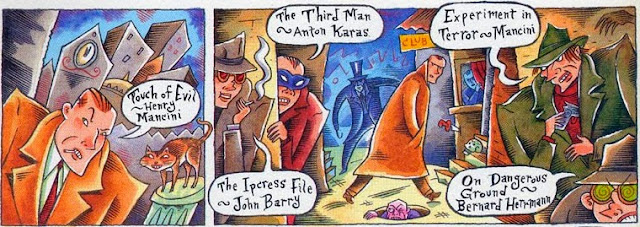 |
| Samurai Flamenco, "Capture Samumenco!" |
Every Friday in "'Brokedown Merry-Go-Round' Show of the Week," which was formerly called "5-Piece Cartoon Dinner," I discuss the week's best first-run animated series episode I saw. It's time to look back at the biggest standouts of the episodes I discussed in 2013 (in chronological order). "Brokedown Merry-Go-Round," a two-hour block of original score tracks from animated shows or movies, airs weekdays at 2pm Pacific on AFOS. "'Brokedown Merry-Go-Round' Show of the Week" returns on January 10.
Bob's Burgers, "Mother Daughter Laser Razor" (from January 9, 2013)
It took me about a few episodes of
Bob's Burgers to get used to the weirdness of female characters being voiced by male comedians (kind of like how a viewer who's never seen
The Venture Bros. before catches
TVB for the first time and keeps wondering, "Why does that brunette chick sound like a dude?"), but now that I'm no longer distracted by that casting quirk, I consider
Bob's Burgers to be the current crown jewel of the Fox "Animation Domination" block.
Bob's Burgers creator Loren Bouchard has taken the best elements of his Squigglevision cartoons
Dr. Katz, Professional Therapist and
Home Movies--overlapping dialogue, great comedic voice acting by performers who weren't previously associated with animation, nicely written kid characters--and put them into a show with top-shelf animation (no off-putting squiggling during this one).
Add to those elements a recurring and interesting art-vs.-commerce conflict between Bob (H. Jon Benjamin) and his business rivals that
Bouchard has said was inspired by the 1996 Italian restaurant movie
Big Night--plus timeless storylines that deal with the unspoken affection the family members have for each other without getting too goopy--and you have a cartoon that's outlasted the
Allen Gregorys and
Napoleon Dynamites of the world and, due to its timeless writing, has the potential to age better in reruns than
Family Guy's random pop-culture reference gags and the equally reference-heavy and spotty later seasons of
The Simpsons. "Mother Daughter Laser Razor" is a great example of the Bouchard show's exploration of the bonds between the Belchers without resorting to those sitcom hugging scenes that made '80s studio audiences go "Awww" and made me want to go shoot myself.
Written by Nora Smith, "Mother Daughter Laser Razor" pairs off two characters who don't share a lot of scenes together--nine-year-old sociopath Louise (Kristen Schaal) and the parent she doesn't favor, the overly perky Linda (John Roberts, one of two male cast members on this show who voices females)--while continuing to explore how Louise's older sister Tina (Dan Mintz, the other actor playing female) seems to have inherited everything from Bob. Those attributes include a lonely and largely friendless childhood similar to the one we saw young Bob experience in "Bob Fires the Kids," Bob's calm demeanor and now, his hairiness.

At Dad's restaurant, Tina overhears a couple of popular classmates gossiping about another girl's hairy legs and realizes her own legs are equally hairy and susceptible to ridicule, so she asks Bob to take her to get her legs waxed after a couple of failed attempts to have them sheared. Lin was supposed to shave Tina's legs, but Lin, who's been fuming over Louise's frequent hostility towards her, is too distracted and angry to be entrusted with a razor, and as resident weirdo sibling Gene (Eugene Mirman) notes in one of the few observations of his that make any sense, "I don't think you should shave angry."
Lin's misguided solution to getting Louise to like her better is to trick her into taking part in a mother-daughter bonding seminar run by Lin's current favorite mommy blogger, "the Phenomimom," who turns out to be a creepy man named Dakota (Tim Heidecker from
Tim and Eric Awesome Show, Great Job!) who holds his seminars next door to a laser-tag fun zone that's more to Louise's liking. Dakota's "Modo Time" methods of getting disgruntled kids to bond with their moms are, of course, pointless and ineffective. They range from lame role-reversal improv games to forcing the kids to re-experience their days as fetuses while trapped inside "vagi-sacks," a.k.a. sleeping bags.
Because
Bob's Burgers is a very good cartoon as opposed to a sloppy one like
The Simpsons' fake
Itchy & Scratchy & Poochie Show that sets up the presence of a fireworks factory and then fails to utilize it as a gag, "Mother Daughter Laser Razor" makes it to the fireworks factory when Louise frees herself and the other kids from their hellish seminar experience and leads them to escape to the laser-tag fun zone, where Louise and Lin finally end up bonding over laser guns aimed at an enraged Dakota. If this were
The Young Ones, the anarchic Louise's love of destruction and criminal activity would make her Vyvyan. Between the attraction to laser-tag and her enjoyment of Bob's favorite spaghetti westerns in "Spaghetti Western and Meatballs," I wouldn't be surprised if this mini-Vyv grows up to become an action movie director, just like how Gene is bound to become either a hacky morning zoo DJ or a hacky stand-up and Tina is headed towards becoming either a chef like her dad or an essayist penning Paul Feig-esque best-sellers about her awkward adolescent experiences.
The kid characters are the best part of
Bob's Burgers. That's mainly because they--particularly the nutty and over-enthusiastic Gene--talk and behave more like real kids who don't really know much about the world outside the restaurant and the playground and less like precocious Huey Freeman-style stand-ins or Mary Sues for their adult creators (although Aaron McGruder's use of Huey as the voice for his politics on the
Boondocks cartoon works quite well for that show).
My favorite example in this episode of the Belcher kids being such kids--other than Gene's desire to get a scrotal wax despite not fully grasping how painful it likely is--is a quick gag that's easy to miss, and a lot of them can be easily missed due to the overlapping dialogue that's distinguished
Bob's Burgers from
The Simpsons and the Seth MacFarlane cartoons. When Louise tries to back out of mother-daughter time, she communicates to Lin her reluctance to spend time with her by using break-up lines she's overheard from either dozens of break-up conversations between couples at the restaurant or break-up scenes in rom-coms: "Look, I think we should spend some time apart. I'm just not really looking for something serious right now. You understand--I mean, yeah, it's gonna be a little awkward, you've got some of your stuff at my place, we live together..." "I think we should spend some time apart" are words I hope I'll never have to say to
Bob's Burgers.
***
Archer, "Fugue and Riffs" (from January 23, 2013)
Episodes like "Fugue and Riffs,"
Archer's wildly funny and violent fourth-season premiere, are exactly why I wanted to expand "5-Piece Cartoon Dinner" to include adult cartoons at the end of last year. "When the new year approaches," I asked myself, "do you want another year of sitting through
Ben 10 reboots that cause your attention to wander or awfully written
Ultimate Spider-Man episodes, or do you want to put that part of your time to better use, like covering adult cartoons that are more up your alley and are worthier of discussion and analysis?"
"Fugue and Riffs" is the kind of adult cartoon episode I should have been focusing on in the first place. It's another sharply written story involving ISIS agent Sterling Archer's ongoing conflict with his mother/boss Malory (Jessica Walter), and it contains a brilliant crossover with lead voice actor
H. Jon Benjamin's other current cartoon, more semi-nudity from Lana Kane (Aisha Tyler) and
esoteric references that are funny simply because they're so damn esoteric (British spy hero Thomas Elphinstone Hambledon! Manning Coles, the duo that created Hambledon! The star of
Shazam! Émile Zola!). You won't see Spidey cracking a joke that's a nod to Zola's "J'accuse" letter during
Ultimate Spider-Man, that's for damn sure.
The season premiere opens with Archer tending the grill at the exact same titular restaurant from
Bob's Burgers, Benjamin's other show, while surrounded by the Belcher kids and Linda (John Roberts, the only
Bob's Burgers voice actor reprising his role), who gets to berate Archer with one of the
various insulting nicknames that have become one of the Adam Reed cartoon's trademarks ("Well, excuse me, Ike Turner!"). Instead of appearing in their more familiar character designs from
Bob's Burgers, Tina, Gene, Louise and Linda are awesomely redesigned to blend in with
Archer's '60s comic book aesthetic.
I like how the cold open strings us along into thinking Archer is undercover as a burger joint owner as part of some ISIS op, until it becomes clear that it's no op and he has no memory of his life as an ISIS agent, although a few pieces of that life remain. They include fighting skills, which Archer puts to use during a badass and extremely gory restaurant confrontation with KGB assassins straight out of
A History of Violence, his literary tastes (he dubs the restaurant's newest burger "a Thomas Elphinstone Hambledurger with Manning Coleslaw") and his metrosexual side ("What I am gonna do is find out who this Archer jerk is... I'm also probably gonna do a spa weekend").
It turns out that two months ago, Archer developed amnesia due to a moment of extreme stress and ran away to a new life as a seaside fry cook named Bob. He married Linda and apparently became her second husband, which makes me wonder what happened to the original Bob in this universe (Alex, I'm gonna go with "What is dead?," and because much of this show's humor thrives on kinky or
freaky behavior, I wouldn't be surprised if Linda has been remolding Archer
Vertigo-style to look more like Bob). Both ISIS and the KGB are after Archer for different reasons: Malory assigns Lana, Cyril (Chris Parnell) and Ray (Reed) to stage a fake run-in with the KGB in front of Archer to try to jog his memory and get him back to the agency, while bionic villain Barry Dylan (Dave Willis) sends more KGB assassins to eliminate Archer.
Part of the fun of "Fugue and Riffs" is trying to figure out the stressful moment that triggered Archer's amnesia. We're given a clue early on when Malory complains that her son hates seeing her be happy, and when the catalyst is revealed at the end to be neither a bomb explosion nor a
Bourne Identity-style, ISIS-sanctioned attempt on his life, but something far less action-y--Malory's wedding to Ron Cadillac, the most successful Cadillac dealer in the Tri-State Area--it makes perfect sense within the neurotic, wracked-by-mommy-issues world of
Archer. In a great bit of stunt-casting, the show has recruited
Ron Leibman from
The Hot Rock and
Friends, as well as Walter's real-life husband, to voice Malory's new hubby, who's won over everyone at ISIS during Archer's two-month absence and whose presence this season is bound to reignite an old thread from a couple of seasons ago: Archer's search for his biological father. (Archer reportedly
begins to form a bond with Ron in the new season's fourth episode. I can't wait to see if Reed, who's
obsessed with the movies of one-time
Archer guest star Burt Reynolds, will toss into that episode a reference to
The Hot Rock or Leibman's other '70s crime-genre cult favorite,
The Super Cops.)
The rest of the fun of "Fugue and Riffs" involves being reacquainted with the elements that make
Archer such an entertaining adult cartoon, from the batshit crazy behavior of Dr. Krieger (Lucky Yates) and office subordinates Pam (Amber Nash) and Cheryl/Carol (Judy Greer) to the self-satisfaction Archer gets from anything he does or says, particularly his esoteric jokes, as if he's a boy who just discovered cursing. Archer may be a competent, book-smart, sharply dressed and jet-setting spy with a sex life many of us
Archer viewers would kill for, but deep down, he's really just a kid who never grew up and knows only how to be a narcissistic asshole, thanks to screwed-up parenting from an asshole of a parent. "Fugue and Riffs" reinforces Archer's childishness when he woo-hoos like a kid over the Molotov cocktails he and Lana lob at the assassins, or when one of Lana's attempts to get him to remember ISIS tanks and causes him to go off on a tangent about his love for
Shazam!, which sometimes crossed over with the superheroine show
The Secrets of Isis in the '70s--a nod to how this episode crosses over with
Bob's Burgers.
No wonder Archer identifies so much with Shazam, née Captain Marvel, even in his fugue state. Shazam is a boy in a grown man's body, just like Archer.
***
Regular Show, "That's My Television" (from March 6, 2013)
Regular Show writers/storyboarders Madeline Queripel and Andres Salaff were responsible for one of the show's most unengaging shorts, this season's Fourth of July-related "Firework Run," a borderline racist episode that felt like a right-winger's worst nightmare about the Mexican gangster villains from Robert Rodriguez's Mariachi trilogy, even though Salaff himself is Latino (at the end of "Firework Run," the main heavy was revealed to have been a robot, perhaps a "
Kim Jong Il is really
an alien cockroach, so that's why we made his Engrish accent so cartoonishly thick"-style attempt to make the episode come off as less racist.) Queripel and Salaff also happen to be behind one of the show's best shorts, "That's My Television," an imaginative and wildly funny installment where Mordecai and Rigby come to the rescue of one of their favorite childhood TV stars, a talking TV set named RGB2 (Sam Marin), who's grown tired of showbiz and wants to flee to a much quieter life in a destination known as "Pine Mountain."
RGB2 starred as himself on the crappy '80s sitcom
That's My Television, and a nameless TV network has brought back into production the still-popular show, which brings to mind every corny '80s housekeeper sitcom you've seen, whether it's
Gimme a Break,
Mr. Belvedere or TBS'
ultra-cheesy Down to Earth (RGB2's signature catchphrase is "I hope you saved room for dessert!"). But RGB2--who needs to ingest cans of "'80s Air"
a la Perri-Air from
Spaceballs in order to survive--isn't enjoying a single minute of the revival, especially because the network is run by an intimidating exec who looks like Cartoon Network founder/owner Ted Turner (but doesn't sound like him at all and is voiced here by
Jeff Bennett) and sends armed thugs in suits to threaten his stars if they don't do what he says.
At RGB2's Comic-Con-style meet-and-greet with his fans, Mordecai and Rigby win a drawing to receive
That's My Television DVDs signed on the spot by RGB2 himself, and the star secretly pleads with the duo to help him escape to Pine Mountain. Mordecai and Rigby agree to help out their sitcom idol--it's not surprising that these slacker park workers identify with a domestic worker who frequently gets into comedic misunderstandings with the head of the household ("RGB2, room for dessert doesn't actually mean a whole room full of dessert!")--and their kind gesture sends Faux-Ted and his network thugs chasing after them in the most entertaining animated car chase I've seen in a while. Either Queripel or Salaff is enamored with both
Casino Royale's badass airport tarmac stunt in which the jet wash of an incoming plane sends
a police car flying through the air and the
Guinness World Record-breaking Aston Martin cannon roll stunt from the same film because during the chase sequence, a couple of the network minions' Humvees are seen tumbling through the air in similar fashion.
RGB2 is clearly a riff on ALF, R2D2 and the dwarf actors who played them:
Michu Meszaros sweated his balls off inside ALF's costume whenever a scene on
ALF didn't call for the ALF puppet to be used, while R2 was operated by
Kenny Baker, whose autograph adorns the liner notes of my CD copy of the expanded 1977
Star Wars soundtrack. The parallels to Meszaros and Baker are made plainly clear in the episode's nutty, disturbing and oddly affecting twist ending, when Mordecai and Rigby discover that RGB2 isn't a sentient TV set and has actually been a naked old actor inside the TV the whole time, which explains the need for '80s Air to help the poor guy breathe inside that damn TV. The dying man's destination turns out not to be a mountain but a billboard in the middle of nowhere for Pine Mountain Gas (presumably the gas station he either left behind to pursue stardom or was discovered at when the network was on the lookout for someone to operate RGB2).

Just like how this naked guy stayed hidden inside what was basically a mobile prison for over three decades, hidden within the '80s gags, the hilariously over-the-top car chase, the gunplay and the jabs at both focus group-driven TV and network exec jargon are serious questions about fandom, the pressures the public puts on TV stars and viewers' relationships with those stars and the TV industry--hence the double meaning of the title "That's My Television," which refers to both RGB2's show and people's attachment to the idiot box. The episode asks us to decide which kind of TV fan do we want to be by presenting two types of fans. Do we want to become so attached to TV that we degenerate into the mean and deranged middle-aged fangirl from RGB2's meet-and-greet who doesn't care for the well-being of a star like RGB2 and demands that he continue to entertain her even if the entertainer isn't happy or right in his mind or is endangering his own life by playing this character? Or do we want to be more like Mordecai and Rigby, who aren't as out-of-control in their fandom, are more understanding about RGB2's misery and are treating him more like a human being--even though for almost the entire episode, they think he's just a talking TV set?
"That's My Television" also questions whether it's worth it for performers like RGB2's portrayer to sacrifice a normal life--and their health--for fame and syndication money. Fortunately, the episode raises these questions without a single bit of speechifying and without trotting out Mordecai and Rigby after the episode to address the audience and deliver a moral like Filmation used to do with its characters. That's how terribly written most cartoons used to be back in the day. To borrow the words of one of the network thugs who get attacked by Mordecai, Rigby and RGB2 with weaponized cans of '80s Air, "Aw, sick! It smells like the '80s!"
Other memorable quotes:
* RGB2 defends himself with a rocket launcher: "It was a gift from the Russian Prime Minister! He loves the show!"
* "Bravo, gentlemen, bravo! Overall, that was a pretty nice PG getaway. Way to reach out to the 18-to-35 demographic. Oh, and nice third-act climax, by the way. The helicopter explosion really tied it all in with a cherry on top."
* "We just have a couple of notes for you. You see, our research groups have shown that nobody wants to see the good guys win anymore."
* The network exec threatens Mordecai, Rigby and RGB2 with his new, heavily armed and
Poochie-like action star, who emerges on a skateboard: "Our focus group studied everything that boys ages nine to 14 find the most brutal and destructive!"
* "I'm not dead! I was just resting."
***
Scooby-Doo! Mystery Incorporated, "Come Undone" (from April 10, 2013)
"Come Undone," the
Scooby-Doo! Mystery Incorporated series finale, takes one of the most wack and least imaginative story resolutions in sci-fi,
the reset button, and somehow makes it work, much like how
Mystery Incorporated took a franchise that was entertaining only when you were a kid--and had become so unwatchable--and made it appealing again and genuinely dark and funny. The Mystery Incorporated team manages to defeat the Evil Entity, the previously imprisoned Anunnaki deity that's responsible for all the costumed criminals and evilness in Crystal Cove and has ended up consuming all of the town's inhabitants except for the detectives (in a series of scenes that are the darkest and bleakest this franchise has ever gotten and are therefore, awesome). Their triumph over the entity erases every trace of it from existence and creates a new timeline where Crystal Cove, "the Most Hauntedest Place on Earth," is now "the Sunniest Place on Earth" because the entity wasn't there to corrupt any of it.
Fred, Daphne, Velma, Shaggy and Scooby discover that their lives in this new timeline are perfect, and everyone who was previously killed off, including Velma's lesbian lover
Marcy (let's face it,
Linda Cardellini's reading of Marcy's last line in "Come Undone," "That's my girl," confirms it), is alive again. (Patrick Warburton's Sheriff Stone says the funniest line in "Come Undone," when he introduces his and Mayor Nettles' kids: "Now Eastwood, Norris and Little Billy Jack need to be asleep by eight. Lynda Carter here can stay up as long as she likes, on account of her being more adorable than her brothers.") But in a great turn of expectations, everyone in the team is dissatisfied with this timeline because there are no mysteries for them to solve.
Then here's where "Come Undone" cleverly handles the reset button: previous
Mystery Incorporated guest star Harlan Ellison--the new Mr. E in this timeline and the only other person who knows of the changes the team made to the previous timeline because of his ability to see the events of alternate dimensions--contacts the detectives to let them know that he's enrolled them as students at his campus of
Miskatonic University, the same setting from H.P. Lovecraft stories. At Miskatonic, there'll be plenty of mysteries for the team to solve, so in a brand new Mystery Machine they repaint after they destroyed the previous one earlier in the season, the detectives drive off to Miskatonic, perhaps encountering a few mysteries along the way, much like the ones they stumbled into while on the road back in the late '60s and early '70s. That means the entire run of
Mystery Incorporated was basically a prequel to
Scooby-Doo, Where Are You!
It's a brilliant way to end a cartoon that modernized Scooby and made it more like a Joss Whedon show by stocking it with snappy dialogue or in-jokes for older viewers (my favorite recent gag that no Cartoon Network viewer under 30 would understand was former MTV VJ Martha Quinn as herself, attempting to sell the detectives a bootleg of a Scritti Politti Christmas album that was recorded in Esperanto) and raising the stakes by building elaborate, apocalypse-related mythologies, which is interesting because
Buffy affectionately borrowed from Scooby and nicknamed its central heroes the Scooby Gang. (Whedon regular Amy Acker even turned up on
Mystery Incorporated and voiced the benevolent Anunnaki being who possessed Scooby's puppy girlfriend Nova.) The showrunner of the next animated Scooby incarnation should just give up. Whatever he has in mind for his iteration of those meddling kids is hardly going to be as good as
Mystery Incorporated was.
***
American Dad, "The Missing Kink" (from April 17, 2013)
If there's any
American Dad episode that I wish a group of radicals (much like the counter-protesters who came up with
a bunch of brilliant ways to mock hateful protesters from the Westboro Baptist Church at the 2010 San Diego Comic-Con) would show in a screening room if they kidnapped the members of the Parents Television Council, strapped them down and forced them to watch some great comedic TV made for adults while subjecting them to some sort of Ludovico treatment-like experiment so that their heads would explode, and then they'd wind up catatonic so that they'd shut the fuck up and stop trying to ruin adult animation or
adult sitcoms for everybody else, that episode would be "The Missing Kink."



































